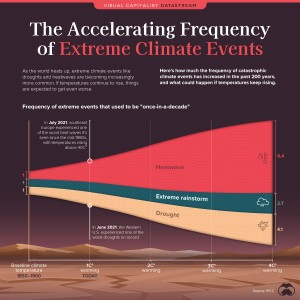Alphabet of Climate Change from A to Z, Now “W” for Weather
>>> Adapted from the Article by Elizabeth Kolbert, New Yorker Magazine, November 28, 2022
The National Oceanic and Atmospheric Administration tracks weather-related disasters in the U.S. that cause more than a billion dollars’ worth of damage. According to NOAA, in the nineteen-eighties the U.S. saw an average of three such disasters per year. In the nineteen-nineties, the average was five per year; in the two-thousands, it was six; and in the twenty-tens it jumped to twelve. (The figures have been adjusted for inflation.)
In 2020, a record-shattering twenty-two disasters costing more than a billion dollars struck the country. This year is nearly on pace to match that record, with fifteen such disasters by October, including Hurricane Ian, which is likely to prove one of the most expensive storms in American history.
Adam B. Smith, a NOAA researcher, has written that a disastrous number of disasters “is becoming the new normal.” The rise is partly a function of more people living in vulnerable areas, such as floodplains. But increasingly it’s a function of climate change.
In the future, the costs may climb steeply or they may climb precipitously. All our infrastructure has been built with the climate of the past in mind. Much of it will have to be rebuilt and then, as the world continues to warm, rebuilt again.
To protect the Houston area (and its many petrochemical plants) from rising seas and storm surges, the U.S. Army Corps of Engineers is planning to erect a huge system of gates at the mouth of Galveston Bay. The price tag for the project, known as the Ike Dike, is estimated at thirty billion dollars.
Norfolk, Virginia, is hoping to stave off the water with a $1.5-billion series of barriers, levees, and tidal gates, and Charleston, South Carolina, is looking to build a billion-dollar flood wall. Some places — large swaths of Miami, for instance — may prove impossible to defend, meaning that real estate now valued in the hundreds of billions of dollars will have to be written off.
#######+++++++#######+++++++########
~. ~. The Accelerating Frequency of Extreme Weather ~. ~.
From an Article by Carmen Ang, Visual Capitalist, January 13, 2022
The world is already witnessing the effects of climate change.
A few months ago, the western U.S. experienced one of the worst droughts it’s seen in the last 20 years. At the same time, southern Europe roasted in an extreme heatwave, with temperatures reaching 45°C (113°F)in some parts.
But things are only expected to get worse in the near future. Here’s a look at how much extreme climate events have changed over the last 200 years, and what’s to come if global temperatures keep rising.
A Century of Warming & More of Same Going Forward
The global surface temperature has increased by about 1°C (1.8°F) since the 1850s. And according to the IPCC, this warming has been indisputably caused by human influence.
As the global temperatures have risen, the frequency of extreme weather events have increased along with it. Heatwaves, droughts and extreme rainstorms used to happen once in a decade on average, but now:
Heatwaves are 2.8x more frequent
Droughts are 1.7x more frequent
Extreme rainstorms are 1.3x more frequent
By 2030, the global surface temperature is expected to rise 1.5°C (2.7°F) the Earth’s baseline temperature, which means that:
Heatwaves would be 4.1x more frequent
Droughts would be 2x more frequent
Extreme rainstorms would be 1.5x more frequent
The Ripple Effects of Extreme Weather
Extreme weather events have far-reaching impacts on communities, especially when they cause critical system failures.
Mass infrastructure breakdowns during Hurricane Ida this year caused widespread power outages in the state of Louisiana that lasted for several days. In 2020, wildfires in Syria devastated hundreds of villages and injured dozens of civilians with skin burns and breathing complications.
As extreme weather events continue to increase in frequency, and communities become increasingly more at risk, sound infrastructure is becoming more important than ever. [The importance of net-zero projects cannot be over emphasized. WiN = When is Now!].
